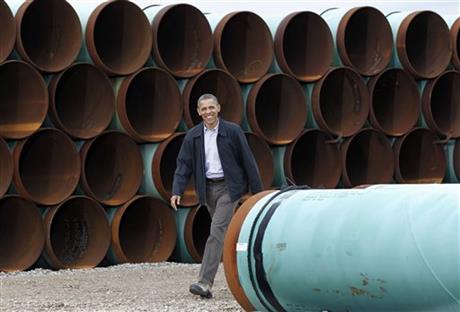The federal review of the proposed Keystone XL oil pipeline from Canada to Texas has dragged on for nearly seven years, more than five times the average for such applications.
The White House insists it’s simply following a standard and well-established process.
In the 6 1/2 years since TransCanada Corp. first applied for a permit, the $8 billion project has become a flashpoint in the debate over climate change.
Under a George W. Bush-era executive order, oil pipelines crossing U.S. borders require a presidential permit, setting off a government-wide review coordinated by the State Department.
An Associated Press examination of every cross-border pipeline application since 2004, when Bush revised the process, shows that the Keystone review has been anything but ordinary.
Since April 2004, when Bush signed his order, the government has taken an average of 478 days — less than a year and a half — to approve or reject all other applications. TransCanada has waited nearly seven years for a ruling.
Former Bush White House officials who helped develop the policy say it was never intended that the final decision about a presidential permit would be delegated to a Cabinet department. The revamped process was intended to quicken permits for major public works projects, those officials said.
Approving a pipeline permit “was seen as the most routine, boring thing in the world,” Robert McNally, who was an energy adviser to Bush.
Republicans and energy advocates have pressed Obama to approve the project, which environmentalists say would promote dirty tar sands oil and risk spills.
The company first applied in September 2008 for a permit to build the 1,179-mile pipeline, which would connect Canada’s tar sands with crude oil refineries on the Texas Gulf Coast.
Controversy over the proposed route through Nebraska led to a tweak, which led the State Department to revisit its assessment. When Congress in 2012 gave Obama a deadline to make a decision, he rejected the permit on grounds he didn’t have enough time to thoroughly review it. He allowed TransCanada Corp. to reapply.
The administration has declined to say what’s taking so long or to offer insight into the deliberations.
“This is under a review process at the State Department. That particular process is a process that predates this administration, so I’m not going to have any update for you from here,” White House spokesman Eric Schultz told reporters recently. He did promise a decision sometime before Obama leaves office in January 2017.
Under Bush’s executive order, the State Department receives permit applications and circulates them to agencies such as the Commerce Department, Energy Department and the Environmental Protection Agency. The agencies have 90 days to offer opinions. If the State Department decides to grant approval, it notifies other agencies, which have 15 days to object before a permit is issued.
The final call comes down to whether the project serves the nation’s interest. In a climate change speech in 2013, Obama established a litmus test: Keystone wouldn’t move forward if it would significantly increase greenhouse gas emissions. That’s a hotly contested matter.
More than 16 months have passed since the State Department’s 30-day public comment period ended. The State Department has not disclosed whether any agencies have objected to the pipeline. The department has said it is continuing to review the application “in a rigorous, transparent, and objective manner.”
The process does not typically drag on this long.
The first permit issued after Bush revised the process in 2004 took less than four months from application to signature. Express Pipeline, L.L.C., was expanding a 785-mile pipeline crossing the Canadian border from Hardisty, Alberta, the same town where the proposed Keystone XL would start.
Even the pipeline that took the longest to approve — the 435-mile Vantage Pipeline Project, approved during Obama’s tenure — took fewer than three years, despite requiring complex negotiations with Native American tribes concerned about historical preservation.
The 1,000-mile Alberta Clipper Project, which drew legal challenges from Earthjustice and other groups, took 25 months to approve.
“When we brought the Alberta Clipper suit, nobody was really paying attention to pipelines,” said Sarah Burt, an Earthjustice attorney. “It hadn’t become this big bargaining chip, this symbolic ask of the administration that Keystone became.”
Not including Keystone XL, eight applications for new or significantly upgraded petroleum pipelines have been processed since April 2004.
The AP’s review excluded permits reissued for existing pipelines due to change of ownership. To come up with an average processing time, the AP culled data from the Federal Register, State Department records, congressional correspondence, Congressional Research Service reports and data provided by pipeline owners.
___




